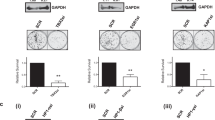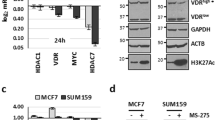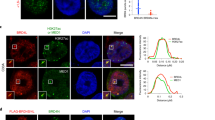Abstract
HIC1 is a newly discovered tumor suppressor and transcriptional repressor that is frequently silenced in human tumors. HIC1 protein expression has been linked to better outcomes in breast cancers. The molecular mechanism underlying HIC1-mediated transcriptional and growth suppression, and the relevant targets of HIC1-mediated transcriptional modulation, is currently unclear. We have identified an HIC1 DNA-binding site in E2F-responsive gene promoters and demonstrate that HIC1 targets E2F-responsive genes for transcriptional regulation and growth suppression. We and others have recently discovered that Brg1, a central component of the SWI/SNF chromatin-remodeling family, is required for the transcriptional regulation of multiple cell cycle control-related genes, including E2F-responsive promoters. We studied HIC1 interactions with, and dependence upon, Brg1 activity, and found that HIC1 can recruit Brg1 to E2F-responsive promoters and that its transcriptional repression of these genes is dependent upon Brg1. These data indicate that HIC1 is a central molecule in a novel mechanism controlling cell growth and that the disruption of this HIC1-mediated pathway may lead to abnormal cell proliferation and, ultimately, cancer.
This is a preview of subscription content, access via your institution
Access options
Subscribe to this journal
Receive 50 print issues and online access
$259.00 per year
only $5.18 per issue
Buy this article
- Purchase on Springer Link
- Instant access to full article PDF
Prices may be subject to local taxes which are calculated during checkout








Similar content being viewed by others
Accession codes
References
Aggerholm A, Holm MS, Guldberg P, Olesen LH, Hokland P . (2006). Promoter hypermethylation of p15, hic1, cdh1, and er is frequent in myelodysplastic syndrome and predicts poor prognosis in early-stage patients. Eur J Haematol 76: 23–32.
Banine F, Bartlett C, Gunawardena R, Muchardt C, Yaniv M, Knudsen ES et al. (2005). Swi/snf chromatin-remodeling factors induce changes in DNA methylation to promote transcriptional activation. Cancer Res 65: 3542–3547.
Bertrand S, Pinte S, Stankovic-Valentin N, Deltour-Balerdi S, Guerardel C, Begue A et al. (2004). Identification and developmental expression of the zebrafish orthologue of the tumor suppressor gene hic1. Biochim Biophys Acta 1678: 57–66.
Betz BL, Strobeck MW, Reisman DN, Knudsen ES, Weissman BE . (2002). Re-expression of hsnf5/ini1/baf47 in pediatric tumor cells leads to g1 arrest associated with induction of p16ink4a and activation of rb. Oncogene 21: 5193–5203.
Britschgi C, Rizzi M, Grob TJ, Tschan MP, Hugli B, Reddy VA et al. (2006). Identification of the p53 family-responsive element in the promoter region of the tumor suppressor gene hypermethylated in cancer 1. Oncogene 25: 2030–2039.
Chen W, Cooper TK, Zahnow CA, Overholtzer M, Zhao Z, Ladanyi M et al. (2004). Epigenetic and genetic loss of hic1 function accentuates the role of p53 in tumorigenesis. Cancer Cell 6: 387–398.
Chen WY, Baylin SB . (2005). Inactivation of tumor suppressor genes: choice between genetic and epigenetic routes. Cell Cycle 4: 10–12.
Chen WY, Wang DH, Yen RC, Luo J, Gu W, Baylin SB . (2005). Tumor suppressor hic1 directly regulates sirt1 to modulate p53-dependent DNA-damage responses. Cell 123: 437–448.
Chen WY, Zeng X, Carter MG, Morrell CN, Chiu Yen RW, Esteller M et al. (2003). Heterozygous disruption of hic1 predisposes mice to a gender-dependent spectrum of malignant tumors. Nat Genet 33: 197–202.
Chopin V, Leprince D . (2006). [Chromosome arm 17p13.3: Could hic1 be the one?]. Med Sci (Paris) 22: 54–61.
Dai Y, Ngo D, Forman LW, Qin DC, Jacob J, Faller DV . (2007). Sirtuin 1 is required for antagonist-induced transcriptional repression of androgen-responsive genes by the androgen receptor. Mol Endocrinol 21: 1807–1821.
Dai Y, Ngo D, Jacob J, Forman LW, Faller DV . (2008). Prohibitin and the swi/snf atpase subunit brg1 are required for effective androgen antagonist-mediated transcriptional repression of androgen receptor-regulated genes. Carcinogenesis 29: 1725–1733.
Dasgupta P, Sun J, Wang S, Fusaro G, Betts V, Padmanabhan J et al. (2004). Disruption of the rb–raf-1 interaction inhibits tumor growth and angiogenesis. Mol Cell Biol 24: 9527–9541.
Deltour S, Pinte S, Guerardel C, Wasylyk B, Leprince D . (2002). The human candidate tumor suppressor gene hic1 recruits ctbp through a degenerate gldlskk motif. Mol Cell Biol 22: 4890–4901.
Dunaief JL, Strober BE, Guha S, Khavari PA, Alin K, Luban J et al. (1994). The retinoblastoma protein and brg1 form a complex and cooperate to induce cell cycle arrest. Cell 79: 119–130.
Fusaro G, Wang S, Chellappan S . (2002). Differential regulation of rb family proteins and prohibitin during camptothecin-induced apoptosis. Oncogene 21: 4539–4548.
Giacinti C, Giordano A . (2006). Rb and cell cycle progression. Oncogene 25: 5220–5227.
Guerardel C, Deltour S, Leprince D . (1999). Evolutionary divergence in the broad complex, tramtrack and bric a brac/poxviruses and zinc finger domain from the candidate tumor suppressor gene hypermethylated in cancer. FEBS Lett 451: 253–256.
Inayoshi Y, Miyake K, Machida Y, Kaneoka H, Terajima M, Dohda T et al. (2006). Mammalian chromatin remodeling complex swi/snf is essential for enhanced expression of the albumin gene during liver development. J Biochem (Tokyo) 139: 177–188.
Lefebvre T, Pinte S, Guerardel C, Deltour S, Martin-Soudant N, Slomianny MC et al. (2004). The tumor suppressor hic1 (hypermethylated in cancer 1) is o-glcnac glycosylated. Eur J Biochem 271: 3843–3854.
Melki JR, Vincent PC, Clark SJ . (1999). Cancer-specific region of hypermethylation identified within the hic1 putative tumour suppressor gene in acute myeloid leukaemia. Leukemia 13: 877–883.
Nevins JR . (2001). The rb/e2f pathway and cancer. Hum Mol Genet 10: 699–703.
Nicoll G, Crichton DN, McDowell HE, Kernohan N, Hupp TR, Thompson AM . (2001). Expression of the hypermethylated in cancer gene (hic-1) is associated with good outcome in human breast cancer. Br J Cancer 85: 1878–1882.
Pinte S, Guerardel C, Deltour-Balerdi S, Godwin AK, Leprince D . (2004a). Identification of a second g-c-rich promoter conserved in the human, murine and rat tumor suppressor genes hic1. Oncogene 23: 4023–4031.
Pinte S, Stankovic-Valentin N, Deltour S, Rood BR, Guerardel C, Leprince D . (2004b). The tumor suppressor gene hic1 (hypermethylated in cancer 1) is a sequence-specific transcriptional repressor: definition of its consensus binding sequence and analysis of its DNA binding and repressive properties. J Biol Chem 279: 38313–38324.
Stankovic-Valentin N, Verger A, Deltour-Balerdi S, Quinlan KG, Crossley M, Leprince D . (2006). A l225a substitution in the human tumour suppressor hic1 abolishes its interaction with the corepressor ctbp. FEBS J 273: 2879–2890.
Stevaux O, Dimova D, Frolov MV, Taylor-Harding B, Morris E, Dyson N . (2002). Distinct mechanisms of e2f regulation by drosophila rbf1 and rbf2. EMBO J 21: 4927–4937.
Strobeck MW, DeCristofaro MF, Banine F, Weissman BE, Sherman LS, Knudsen ES . (2001). The brg-1 subunit of the swi/snf complex regulates cd44 expression. J Biol Chem 276: 9273–9278.
Takahashi Y, Rayman JB, Dynlacht BD . (2000). Analysis of promoter binding by the e2f and prb families in vivo: distinct e2f proteins mediate activation and repression. Genes Dev 14: 804–816.
Waha A, Koch A, Hartmann W, Mack H, Schramm J, Sorensen N et al. (2004). Analysis of hic-1 methylation and transcription in human ependymomas. Int J Cancer 110: 542–549.
Wang S, Fusaro G, Padmanabhan J, Chellappan SP . (2002a). Prohibitin co-localizes with rb in the nucleus and recruits n-cor and hdac1 for transcriptional repression. Oncogene 21: 8388–8396.
Wang S, Ghosh RN, Chellappan SP . (1998). Raf-1 physically interacts with rb and regulates its function: a link between mitogenic signaling and cell cycle regulation. Mol Cell Biol 18: 7487–7498.
Wang S, Nath N, Adlam M, Chellappan S . (1999a). Prohibitin, a potential tumor suppressor, interacts with rb and regulates e2f function. Oncogene 18: 3501–3510.
Wang S, Nath N, Minden A, Chellappan S . (1999b). Regulation of rb and e2f by signal transduction cascades: divergent effects of jnk1 and p38 kinases. EMBO J 18: 1559–1570.
Wong S, Weber JD . (2007). Deacetylation of the retinoblastoma tumour suppressor protein by sirt1. Biochem J 407: 451–460.
Wang S, Zhang B, Faller DV . (2002b). Prohibitin requires brg-1 and brm for the repression of e2f and cell growth. EMBO J 21: 3019–3028.
Wang S, Zhang B, Faller DV . (2004). Brg1/brm and prohibitin are required for growth suppression by estrogen antagonists. EMBO J 23: 2293–2303.
Zhang B, Chambers KJ, Faller DV, Wang S . (2007). Reprogramming of the swi/snf complex for co-activation or co-repression in prohibitin-mediated estrogen receptor regulation. Oncogene 26: 7153–7157.
Acknowledgements
We thank Dr Srikumar P Chellappan for his continuous support. This study was partially supported by grants from Susan G Komen Breast Cancer Foundation Research Award (BCTR0403163) (SW) and the National Cancer Institute ((CA102940) (SW) and (CA101992) (DVF)) and by the Karin Grunebaum Cancer Research Foundation (DVF). SW is the recipient of DOD/CDMRP 2008 Breast Cancer Concept Award, Carter Family Foundation for Melanoma Research grant award, a BUSM Department of Medicine Pilot Project Grant Award and an Aid for Cancer Research grant award.
Author information
Authors and Affiliations
Corresponding author
Rights and permissions
About this article
Cite this article
Zhang, B., Chambers, K., Leprince, D. et al. Requirement for chromatin-remodeling complex in novel tumor suppressor HIC1-mediated transcriptional repression and growth control. Oncogene 28, 651–661 (2009). https://doi.org/10.1038/onc.2008.419
Received:
Revised:
Accepted:
Published:
Issue Date:
DOI: https://doi.org/10.1038/onc.2008.419
Keywords
This article is cited by
-
P53 induction accompanying G2/M arrest upon knockdown of tumor suppressor HIC1 in U87MG glioma cells
Molecular and Cellular Biochemistry (2014)
-
Signification of Hypermethylated in Cancer 1 (HIC1) as Tumor Suppressor Gene in Tumor Progression
Cancer Microenvironment (2012)
-
Epigenetic alterations differ in phenotypically distinct human neuroblastoma cell lines
BMC Cancer (2010)
-
Brg-1 mediates the constitutive and fenretinide-induced expression of SPARC in mammary carcinoma cells via its interaction with transcription factor Sp1
Molecular Cancer (2010)



